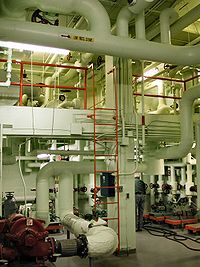Piping

Piping is like a big straw that helps move liquids or gases from one place to another. You might have seen pipes in your bathroom, under the sink or in the shower. They carry water to and from the faucet, so you can wash your hands or take a warm bath.
Just like in your bathroom, pipes are also used in big buildings, factories, and even underground. They help transport water, gas, oil, and other substances from one place to another. They can be made of different materials like metal, plastic, or concrete, depending on what they need to carry and how much pressure they can handle.
Pipes come in different shapes and sizes. Some are thin and small, while others are thick and large like a tree trunk. The pipes that carry gas or oil are usually thicker and stronger because they have to withstand a lot of pressure. The pipes that carry water or sewage are often made of plastic and are flexible.
In order to connect pipes together, people use special fittings. These fittings come in different shapes and sizes too, and they help make sure the pipes are connected tightly together so that nothing leaks out. They can also help change the direction of the flow of the liquid or gas inside the pipe.
Piping is an important part of our everyday lives, and it helps us get the things we need to the places we need them.
Just like in your bathroom, pipes are also used in big buildings, factories, and even underground. They help transport water, gas, oil, and other substances from one place to another. They can be made of different materials like metal, plastic, or concrete, depending on what they need to carry and how much pressure they can handle.
Pipes come in different shapes and sizes. Some are thin and small, while others are thick and large like a tree trunk. The pipes that carry gas or oil are usually thicker and stronger because they have to withstand a lot of pressure. The pipes that carry water or sewage are often made of plastic and are flexible.
In order to connect pipes together, people use special fittings. These fittings come in different shapes and sizes too, and they help make sure the pipes are connected tightly together so that nothing leaks out. They can also help change the direction of the flow of the liquid or gas inside the pipe.
Piping is an important part of our everyday lives, and it helps us get the things we need to the places we need them.
Related topics others have asked about:
